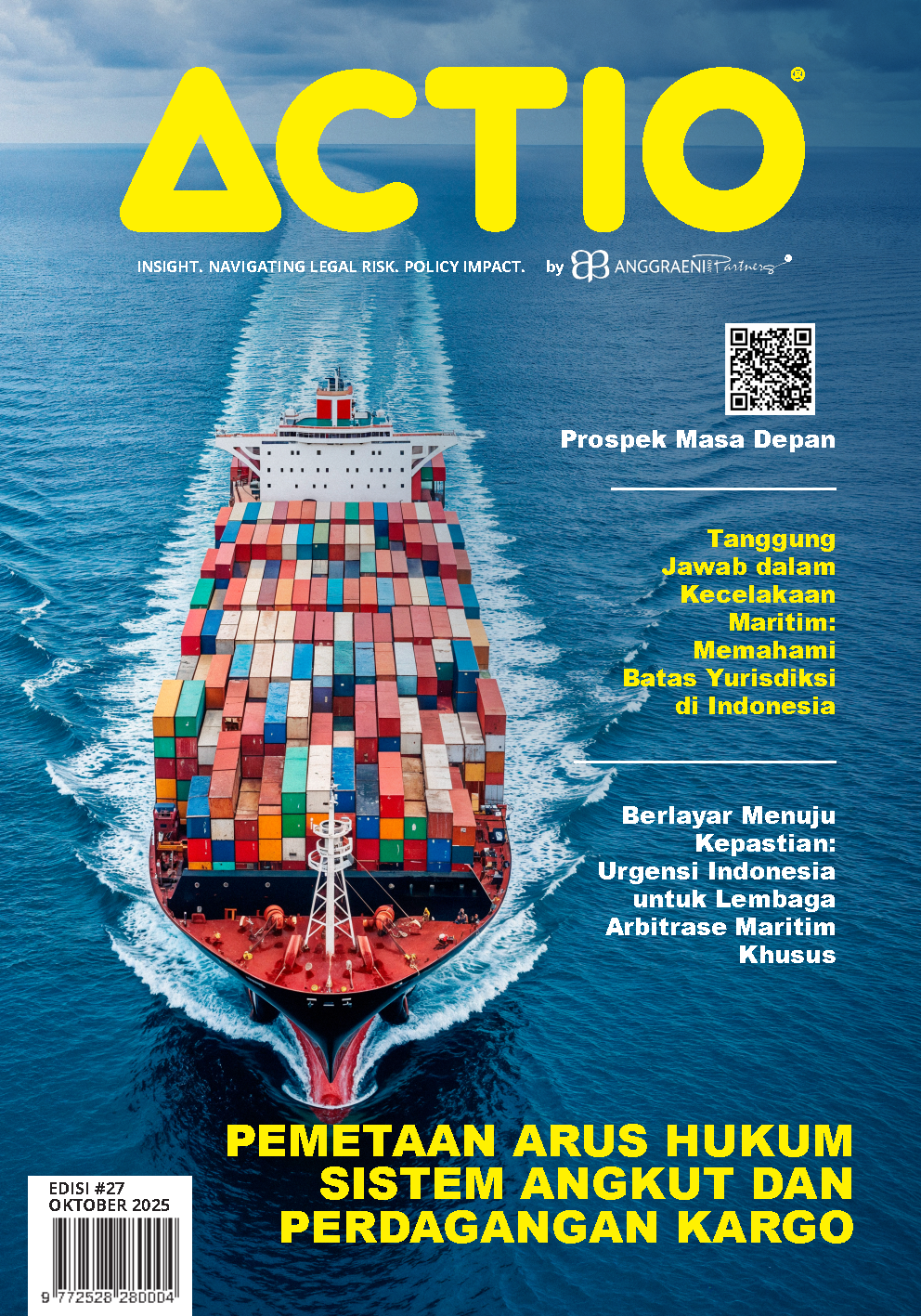Rising Tides : India’s Shipbuilding Boom and Lessons for Indonesia
by Setyawati Fitrianggraeni and Orima Melati Davey
Introduction
India is making a bold bet on its maritime future with a ₹2 lakh crore (approximately USD 24 billion) investment into its shipbuilding sector.[1] This ambitious plan involves developing eight shipbuilding clusters over the next five to six yearsfive of which are entirely new (greenfield projects) and located in Andhra Pradesh, Odisha, Tamil Nadu, Gujarat, and Maharashtra. The remaining three will expand existing shipyards. These efforts are guided by two major long-term strategies: the Maritime India Vision 2030 and the Amrit Kaal Vision 2047, which aims to position India among the world’s leading shipbuilding nations by its 100th year of independence.
India’s Maritime Strategy in Action
India’s plan is not just theoreticalconcrete steps are already underway. The government has introduced a ₹25,000 crore (around USD 3 billion) Maritime Development Fund (MDF) as part of Budget 2025, designed to support infrastructure projects, vessel procurement, and green maritime technologies. The goal is to unlock an additional ₹1.5 lakh crore in leveraged investments by 2030.[2] This aligns strongly with national priorities like Make in India and Aatmanirbhar Bharat, aiming to reduce India’s USD 109 billion ocean freight bill, ramp up domestic defense vessel production, and create thousands of skilled jobs in maritime manufacturing.
Real-world developments are reflecting this momentum. On July 4, 2025, Cochin Shipyard Limited signed a memorandum of understanding with HD Korea Shipbuilding & Offshore Engineering to collaborate on vessel design, technology transfer, and workforce training.[3] Just days later, on July 8, Hindustan Shipyard delivered the Diving Support Vessel Nistar to the Indian Navybuilt with 80% local components and commissioned officially on July 18. Meanwhile, Mazagon Dock is doubling its production capacity with a USD 600 million investment and expanding its reach through a majority acquisition of Colombo Dockyard. A proposed policy requiring Indian-built vessels for coastal shipping from 2030 further underscores India’s long-term commitment.[4]
Regional Dynamics and Indonesia’s Strategic Considerations
India’s aggressive maritime posture has attracted global attention, especially given its relevance to Indo-Pacific trade routes and sustainable shipping practices. It aligns with initiatives like the India–Middle East–Europe Economic Corridor (IMEEC). However, in Indonesia, the conversation remains centered on port upgrades and domestic regulatory reform. While important, this inward focus risks missing opportunities presented by India’s rapid maritime expansion. Indonesia and India already share a Comprehensive Strategic Partnership, offering a potential platform for deeper collaboration. Key areas include green technology transfer, harmonization of shipbuilding standards, and shared infrastructure development. These opportunities are especially relevant as the global shipbuilding market is projected to reach USD 237 billion by 2047. Partnering with India could help Indonesia modernize its own shipbuilding sector and play a more significant role in regional maritime supply chains.
What can Indonesia Learn?
Indonesia can draw several lessons from India’s approach. First, long-term vision mattersIndia’s alignment of maritime goals with broader national strategies ensures continuity and purpose. Second, the use of targeted financial instruments like the Maritime Development Fund shows how public investment can unlock private sector participation. Third, the emphasis on domestic capability-building through local component manufacturing, technology partnerships, and skill development is a blueprint Indonesia could adapt to strengthen its own maritime ecosystem.
Moreover, India’s strategic use of policysuch as mandating Indian-built vessels for coastal operationsdemonstrates how regulation can be a lever for industrial development. Indonesia could consider similar policies that encourage the use of locally built ships or provide incentives for green vessel technology. Finally, India’s global engagement, including partnerships with international shipbuilders and regional dockyards, shows the value of outward-looking strategies in a connected maritime world.
Concluding Remark
India’s shipbuilding plan is more than an industrial investmentit is a strategic move with wide-reaching economic, geopolitical, and environmental implications. For Indonesia, this presents both a challenge and an opportunity. Rather than viewing India’s progress as competition, Indonesia should explore complementary paths. By aligning with India in areas such as green tech, infrastructure development, and maritime regulation, Indonesia can accelerate its own shipbuilding ambitions while strengthening regional maritime resilience. Now is the time for Indonesia to actbefore the tide turns too far in any one direction.
Bibliography
BF Builder’s Friend, ‘India’s Maritime Future: Building Ships, Building Self-Reliance’ (2025) <https://buildersfriend.in/public/index.php/details/india’s-maritime-future:-building-ships-building-self-reliance>
Narayan S, ‘Budget 2025 Proposes ₹25,000-Crore Maritime Development Fund’ (mint, 2025) <https://www.livemint.com/budget/news/budget-2025-budget-speech-2025-nirmala-sitharaman-maritime-development-fund-budget-announcements-11738390620020.html>
The Economic Times, ‘Cochin Shipyard to Partner with HD Korea Shipbuilding & Offshore Engineering in Various Domains’ (2025) <https://economictimes.indiatimes.com/industry/transportation/shipping-/-transport/cochin-shipyard-to-partner-with-hd-korea-shipbuilding-offshore-engineering-for-multiple-projects/articleshow/122249417.cms>
Xavier W, ‘India’s Mazagon Dock Shipbuilders to Invest over $4b in Capacity Upgrades’ (BAIRD Maritime, 2025) <India’s Mazagon Dock Shipbuilders to invest over $4b in capacity upgrades>
[1] BF Builder’s Friend, ‘India’s Maritime Future: Building Ships, Building Self-Reliance’ (2025) <https://buildersfriend.in/public/index.php/details/india’s-maritime-future:-building-ships-building-self-reliance>.
[2] Subhash Narayan, ‘Budget 2025 Proposes ₹25,000-Crore Maritime Development Fund’ (mint, 2025) <https://www.livemint.com/budget/news/budget-2025-budget-speech-2025-nirmala-sitharaman-maritime-development-fund-budget-announcements-11738390620020.html>.
[3] The Economic Times, ‘Cochin Shipyard to Partner with HD Korea Shipbuilding & Offshore Engineering in Various Domains’ (2025) <https://economictimes.indiatimes.com/industry/transportation/shipping-/-transport/cochin-shipyard-to-partner-with-hd-korea-shipbuilding-offshore-engineering-for-multiple-projects/articleshow/122249417.cms>.
[4] Will Xavier, ‘India’s Mazagon Dock Shipbuilders to Invest over $4b in Capacity Upgrades’ (BAIRD Maritime, 2025) <India’s Mazagon Dock Shipbuilders to invest over $4b in capacity upgrades>.
DISCLAIMER :
This disclaimer applies to the publication of articles by Anggraeni and Partners. By accessing or reading any articles published by Anggraeni and Partners, you acknowledge and agree to the terms of this disclaimer:
-
During the preparation of this work, the author(s) may use AI-assisted technologies for readability. After using this tool/service, the author(s) reviewed and edited the content as needed for the purposes of the publication.
-
No Legal Advice: The articles published by Anggraeni and Partners are for informational purposes only and do not constitute legal advice. The information provided in the articles is not intended to create an attorney-client relationship between Anggraeni and Partners and the reader. The articles should not be relied upon as a substitute for seeking professional legal advice. For specific legal advice tailored to your individual circumstances, please consult a qualified attorney.
-
Accuracy and Completeness: Anggraeni and Partners strive to ensure the accuracy and completeness of the information presented in the articles. However, we do not warrant or guarantee the accuracy, currency, or completeness of the information. Laws and legal interpretations may vary, and the information in the articles may not be applicable to your jurisdiction or specific situation. Therefore, Anggraeni and Partners disclaim any liability for any errors or omissions in the articles.
-
No Endorsement: Any references or mentions of third-party organizations, products, services, or websites in the articles are for informational purposes only and do not constitute an endorsement or recommendation by Anggraeni and Partners. We do not assume responsibility for the accuracy, quality, or reliability of any third-party information or services mentioned in the articles.
-
No Liability: Anggraeni and Partners, its partners, attorneys, employees, or affiliates shall not be liable for any direct, indirect, incidental, consequential, or special damages arising out of or in connection with the use of the articles or reliance on any information contained therein. This includes but is not limited to, loss of data, loss of profits, or damages resulting from the use or inability to use the articles.
-
No Attorney-Client Relationship: Reading or accessing the articles does not establish an attorney-client relationship between Anggraeni and Partners and the reader. The information provided in the articles is general in nature and may not be applicable to your specific legal situation. Any communication with Anggraeni and Partners through the articles or any contact form on the website does not create an attorney-client relationship or establish confidentiality.
-
By accessing or reading the articles, you acknowledge that you have read, understood, and agreed to this disclaimer. If you do not agree with any part of this disclaimer, please refrain from accessing or reading the articles published by Anggraeni and Partners.
Setyawati Fitrianggraeni serves as Managing Partner at Anggraeni and Partners in Indonesia and Assistant Professor at the Faculty of Law, University of Indonesia, while pursuing her PhD at the World Maritime University in Malmö, Sweden, where she leads a legal research team focused on Ocean Maritime Climate. The team includes researchers Orima Melati Davey.
For further information, please contact:
P: 6221. 7278 7678, 72795001
H: +62 811 8800 427
Anggraeni and Partners, an Indonesian law practice with a worldwide vision, provides comprehensive legal solutions using forward-thinking strategies. We help clients manage legal risk and resolve disputes on admiralty and maritime law, complicated energy and commercial issues, arbitration and litigation, tortious claims handling, and cyber tech law.
S.F. Anggraeni
Managing Partner
Orima Melati Davey
Legal Researcher
Ocean-Maritime-Climate Research Group
orima.md@ap-lawsolution.net



